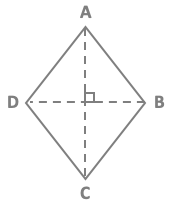Area of a rhombus |

|
|
d1 x d2
2
|
|
Diagonal 1 = d1 Diagonal 2 = d2 AB = BC = CD = DA = c ExampleTake a rhombus with diagonal 1 d1 = 8 cm and diagonal 2 d2 = 3 cm.Area A of the rhombus =
d1 x d2
2
=
8 x 3
2
= 12 cm²
Calculate the area of a rhombus |
Definition of a rhombusA rhombus is a quadrilateral that has 4 sides of the same length.A rhombus is a parallelogram with four equal sides and opposite equal angles. It is a special case of a parallelogram, and it is a four-sided quadrilateral. A rhombus is a quadrilateral whose four sides all have the same length. It is a flat shape with 4 straight sides that are all equal length. The area of a rhombus is equal to half the product of the lengths of the diagonals. The plural of rhombus is "rhombi" or "rhombuses". A diamond is also categorized as a rhombus, because it has four equal sides and its opposite angles are equal. A rhombus can be a square. A square is a special case of a rhombus. Indeed if a rhombus has four equal interior angles, it is a square. A rhombus is not a square unless the angles are all right angles. However a square is a rhombus since all four of its sides are of the same length. If a rhombus has two acute angles and two obtuse angles, it takes the shape of a diamond. A rhombus is a special type of a parallelogram whose all sides are equal. Properties of a rhombusA rhombus is a parallelogram. Indeed a rhombus has its opposite sides parallel, so it is a parallelogram.The rhombus has its opposite angles of equal measure and its additional consecutive angles. The diagonals of the rhombus intersect in their middle and are perpendicular. A rhombus has two axes of symmetry : its diagonals. A rhombus has a center of symmetry : the point of intersection of its diagonals. All sides have equal length. A rhombus looks like a diamond. The sum of two adjacent angles is equal to 180 degrees. |